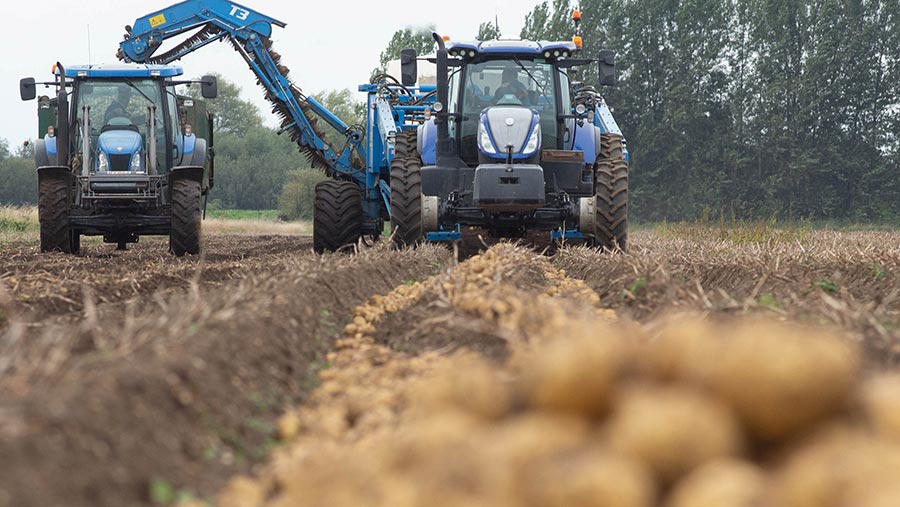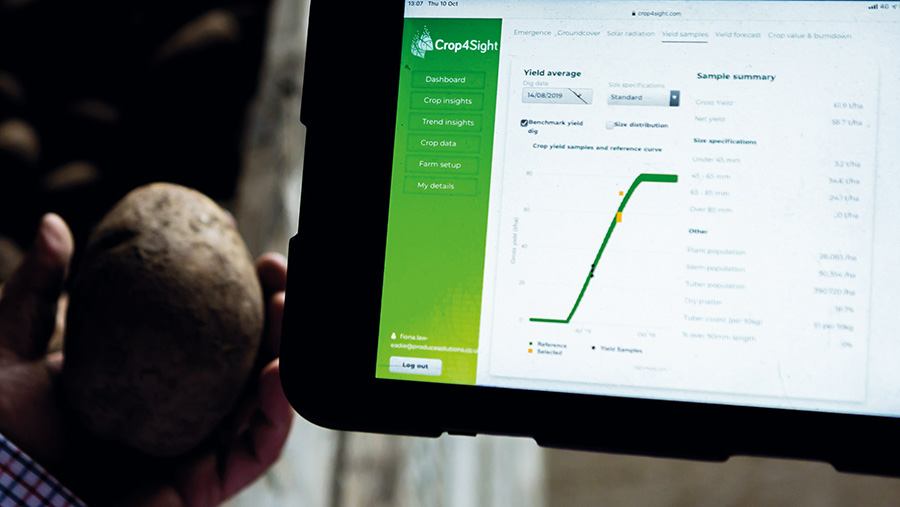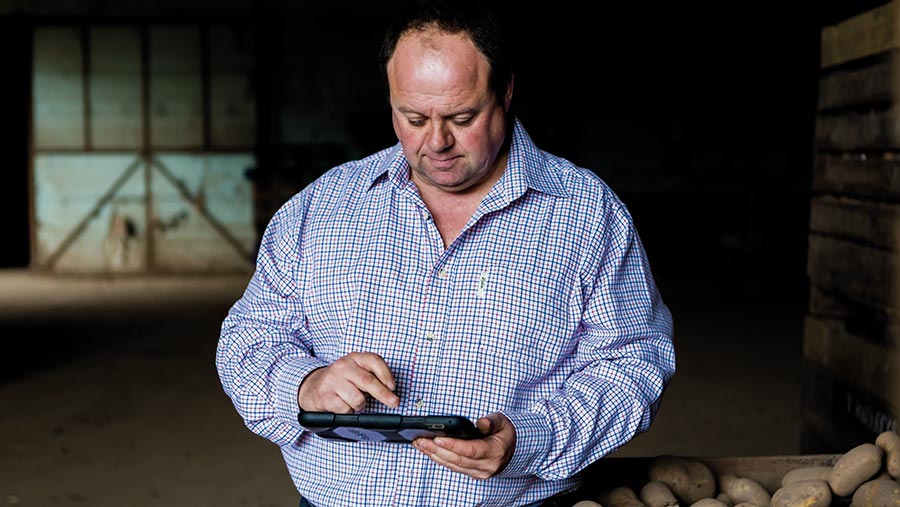How an easy-to-use app can help with tight potato margins
 © Tim Scrivener
© Tim Scrivener At the sharp end of the season, potato maincrops might be increasing or decreasing in value by as much as £100/ha/day as yields increase and segment proportions change.
Harvest too early and yields are unlikely to be maximised; harvest too late and a higher proportion of the crop might be oversized and subject to a lower price.
See also: How the YEN milling wheat champion won gold
This is why the decision on when to initiate burndown is one of the most crucial a potato grower makes. Traditionally, that is based on test digs across the field every couple of weeks, plus a good dollop of experience.
But even with experience, it’s very easy to miss value, suggests Paul Coleman, managing director of Crop4Sight.
Crop4Sight, part of the Produce Investments group, which also includes Greenvale AP, is a start-up technology company aiming to help potato growers optimise saleable crop yields in season.
“We know from seven years of crop yield and sizing data that there is 10% more saleable yield possible on most potato farms. Getting burn-off date wrong by even a day or two can cost a couple of hundred pounds a hectare, and over a 10ha field that soon starts adding up.”
That’s where Crop4Sight aims to improve growers’ decision-making through variety-specific insights and forecasts based on both field-specific data and modelling, backed by data from trials and commercial crops.
“It’s all about improving the saleable potato yield for the grower and getting a bigger percentage of the crop into that fraction,” he says.

© Crop4Sight
Variety factor
Variety-specific data is vital. Potatoes are very different from variety to variety. A Royal canopy with a long top will have a different yield than a determinate variety with a very short top. It’s very complex, so the forecasts need to be variety-specific, driven by real data, he says.
“We update our algorithms and models every year as we accumulate more data from trials and commercial crops.”
Improving performance and efficiency starts before the crop is even planted, he explains.
Most growers plant each field at a single seed rate based on seed count, regardless of planting date, target harvest yield and tuber size, or age of the seed.
“Data from commercial crops tell us this is massively inefficient, with swings of plus or minus 50% of the numbers of tubers/ha compared with the optimum. It’s a building block we can help get right from the start.”
Crop4Sight does that through its dynamic seed module, where seed count, variety, intended yield, intended market, and the physiological age of the seed – calculated from the emergence date of the seed crop and the intended planting date – are used to calculate the optimum seed rate for that planting date.
“We also uniquely forecast the number of stems and the number of tubers/ha that planting should produce.
Managing the right input of seed to get the right number of stems and tubers helps maximise saleable yield.”
What data do growers have to enter to use Crop4Sight?
Minimising the workload required from growers to make the service as user-friendly as possible is a key part of Crop4Sight’s strategy.
“We’re all about using low-cost, easy-to-use technology, such as mobile phones, and investing heavily in tools that can automate as much of it as possible, so the effort the grower needs to put in is the bare minimum, but the output and the visibility of how to improve their value is very easy to obtain.”
Research projects are under way to deliver this further, but currently the following inputs are required from growers:
- Online entry of basic details such as variety, planting date (plus extra information if using the seed module)
- Simple percentage emergence counts twice in two-week period
- Optional: Taking canopy development pictures weekly up until full ground cover using mobile Crop4Sight app increases forecast accuracy
- Early yield dig around 100% ground cover
- Late yield confirmation dig before burndown
Emergence dates
The service also forecasts emergence dates, which helps work out windows for pre-emergence herbicides, and tuber initiation and irrigation start dates.
“As the canopy develops, we forecast the longevity of the canopy, which is important for growers thinking of maleic hydrazide applications.
“As soon as the crop is developed enough – usually just after it reaches 100% ground cover – a yield dig is taken, from which the Crop4Sight models start forecasting what should be the target yield to get the highest proportion of saleable yield, when that will be and the percentage size fractions.”
Those forecasts are incredibly useful for growers, he believes. “Looking at the change in value of that crop each week has been eye-opening.”
For example, most growers typically burn down the biggest crops first when planning a harvesting schedule, but the model could show those crops were still putting on more value each day compared with a medium-sized crop, he explains.
“It changes your perspective on the order in which you should burn crops down, and that is where you gain the value.”
Seed crops
One example of how Crop4Sight can add value came from within a seed potato business, Mr Coleman says.
The usual practice with seed crops is to burn down as soon as you find a tuber over 55mm in size.
“We were able to show this grower from the Crop4Sight models that waiting for an extra 10 days to burn down would have resulted in an extra £3,000/ha on the crop he was selling in an export market for £300/ha. It was a 4ha field, so using Crop4Sight could have made him an extra £12,000.”
Case study – Richard Maddocks, Chadwell Grange, Shropshire

Richard Maddocks © Crop4Sight
Crop4Sight has become an integral part of Richard Maddocks’ potato operation after using it for the past four seasons. “We’ve become heavily reliant on it, as it helps us prioritise the crops with the most potential.”
Growing eight potato varieties across 155ha – split approximately 60:40 between pre-pack for Greenvale and processing for McCain – it has been instrumental in helping make decisions in the growing season about prioritising harvest schedules and maximising value,
he explains.
Early warning system
It also provides an early warning of potential challenges, helping both grower and customer to discuss contingency plans. This was the case last season after a late frost in May resulted in the pre-pack variety
Jelly only having one or two stems/plant rather than the normal four or five stems.
“We knew we would have a very bold crop with low tuber numbers following the initial dig and forecasts from Crop4Sight,” Mr Maddocks explains.
“That allowed us to give our customers information about what crops we were expecting 10 weeks ahead of harvest, and discuss changing our specification upper limit from 85mm to 90mm. It also allowed our customer to plan to blend in other crops where tuber sizes were smaller.”
With margins increasingly tight, he also likes the way in which the model helps maximise value from his crops. It allows him to plan in early August the order in which to desiccate fields and when to fulfil his 400t/week contract over eight weeks with Greenvale, while maximising returns.
“Our returns can be affected massively by just five days’ difference in desiccation date – by up to £300-£400/ha.”
After adding prices for different specs – undersized, mediums and bakers, and oversized – to the model, it can be used to create scenarios for different desiccation dates, helping Mr Maddocks choose the optimum date for maximum returns, and understanding when margins will start reducing. “It quickly pays for the model,” he concludes.
New irrigation module in testing
The latest addition to the Crop4Sight portfolio is an irrigation water balance module, which uses a “unique data source” to pre-populate rainfall data.
Compared with the gold standard Niab irrigation balance sheet, the module will reduce the amount of information growers have to input by automating from existing data sets, Crop4Sight managing director Paul Coleman says.
That includes using a data source that gives derived rainfall for a field, so if a grower hasn’t updated with actual rain gauge figures or doesn’t have a gauge in every field, which can be time-consuming, the model is still using data to create a schedule. “It’s better than no update and in testing we’ve found it to be accurate enough.”
Another key advantage is the ability to create new schedules as often as necessary.
“Most schedules give you a week plan, which if an unexpected storm happens during the week, it’s not updated until the following week. Our system is live so you can pull up an irrigation schedule at the touch of a button,” he explains.

